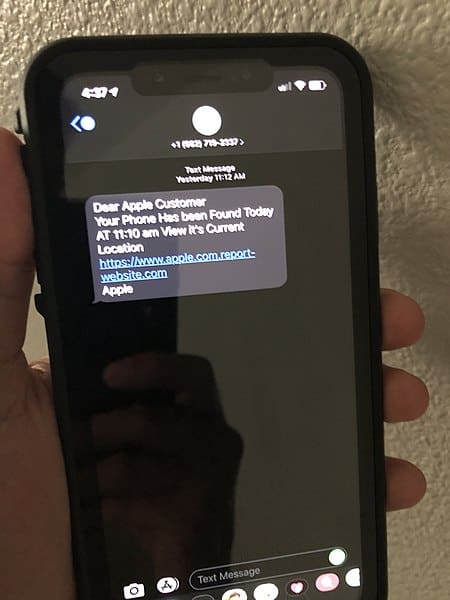How to Recognize Fake Text Message Scams (Smishing)

Smishing is a dangerous breach of security, executed by hackers. Many innocent people fall victim to this scam. It has been reported that on average, 376,032,733 spam texts are sent every day. Spam texts are a favored method of perpetuating fraud, as they are cheap and easy to send. They are often disguised as a service message or an update.
The following guide will explain how to identify spam text messages and the measures necessary to avoid falling for them.
Let’s get started!
What is Smishing?
Smishing is a spam activity performed through SMS texts. The received text would seem to be from a reliable source or a trusted sender. Once the user has received the message, it is the user’s responsibility to figure out its reliability. At the end of the smishing process, the sender’s motive is to steal personal, financial, or any other sensitive data from the user’s device. Finally, the gathered data is used for illegal activities.

Why Are Text Message Scams Popular?
There are many reasons for the increase in text message scams, including:
- Speed of communication: Text messages are by far the fastest medium of communication.
- Poor authentication: The phone numbers or the text messages are not authenticated in-depth. There is no prescribed method to check the authenticity of the sender.
- Higher usage: There is a high usage of text messages. It is cheaper and reaches people in high volumes.
- Lower cost: Text messages are cheap to send
- Higher chance of response: Because so many people use text messages daily, there is a high likelihood of engagement.
How to Identify Scam Text Messages?
Generally, scam texts are creatively written and differ from one another. However, there are usually some giveaways in identifying them. Let’s check them out!
“You’ve Won a Prize!”
A text message indicating that the user has won a prize or giveaway is sent in this instance. Then, the sender would demand money or personal information before the victim can claim the prize.
The simple solution for confirming the authenticity of a text is to check out the specific prize offers on the brand’s website or make contact through an official phone number. Until you confirm the authenticity of any text messages, never reply, or respond.
Long Numbers
Generally, SMS marketing texts are received from 6-digit short codes, a 10-digit toll-free number, or a local phone number. But, if you receive a message from an 11-digit number, there is a high chance of it being a scam.
Emergency Texts
These emergency texts appear to originate from family or friends. For example, you might get a weird message from a family member in a faraway place in need of urgent help. They may also mention that contacting them personally could cause harm to them.
In a case like this, contact someone close to the person allegedly in trouble to verify the authenticity of the message. You can also ask personal questions that only the purported sender of the text could answer.
Reactivation Scam
Reactivation scam messages inform the user that a specific account is deactivated. Then, they request the user to send their username and password to activate the account. No one has a legitimate reason for requesting a username or password via text, so you should NEVER share that info. Instead, check the account in question to confirm whether it is deactivated. Do this by contacting the organization or company directly via phone call or on their website.
Refund Scams
Refund scams inform you about bill payments and overcharges. Next, they request to make a direct deposit to your account to reverse the charges. Once they have your banking information, they are on their way to stealing your money.
Pay Yourself Scam
You receive a text message, allegedly from your bank, about unusual activity. The text may ask if you made a purchase in a certain amount from a specified merchant
If you respond to the text, you may receive a call from a number that looks like it’s from a bank.
The person on the call may claim to be a bank representative and offer to help stop the alleged fraud by asking you to send money to yourself with Zelle.
The scammer will ask you for a one-time code you just received from a bank.
If you give them the code, they will use it to enroll their bank account with Zelle® using your email or phone number.
The scammer now can receive your money into their account.
How to Stop Text Scams or Smishing Messages?
If you are receiving text scams or smishing messages frequently, you can use the following steps to avoid being trapped:
- Don’t trust caller ID — it’s not always whom it says it is.
- Don’t share codes based on a call you receive.
- Never click on any unauthorized links received from unknown or unreliable numbers
- Don’t be pressured to act immediately
- Act slowly and patiently to prevent being scammed
- Don’t be afraid to simply delete the message if you are unsure of the sender.
Conclusion
Smishing is a tactful move by a hacker to steal from you, and it is easy to fall victim if you don’t recognize it. This guide provides insights about smishing messages, how to recognize them and how to safeguard yourself. This problem is likely to become even bigger over time, so be vigilant.
Additional Resources:
- “How to Recognize and Report Spam Text Messages” – https://consumer.ftc.gov/articles/how-recognize-and-report-spam-text-messages
- “Mobile Phone Texts: Spam and Scams” – https://www.fcc.gov/news-events/blog/2020/03/02/mobile-phone-texts-spam-and-scams
- “Avoid the Temptation of Smishing Scams” – https://www.fcc.gov/avoid-temptation-smishing-scams
- “Text Scams: How to Avoid and Report Them” – https://www.kiplinger.com/retirement/text-scams-how-to-avoid-and-report-them
- “Here’s How to Avoid IRS Text Message Scams – YouTube Video Text Script” – https://www.irs.gov/newsroom/heres-how-to-avoid-irs-text-message-scams-youtube-video-text-script
- “Text Message Phishing (Smishing)” – https://www.ag.state.mn.us/consumer/publications/TextMessagePhishing.asp
- “Text Message Scams (Smishing)” – https://www.michigan.gov/ag/consumer-protection/consumer-alerts/consumer-alerts/scams/text-message-scams-smishing
- “Report a Scam Text Message – National Cyber Security Centre” – https://www.ncsc.gov.uk/collection/phishing-scams/report-scam-text-message
- “Smishing and Spam Text Messages – Verizon” – https://www.verizon.com/about/account-security/smishing-and-spam-text-messages
- “Avoid Text Message Scams – Massachusetts Attorney General” – https://www.mass.gov/news/avoid-text-message-scams
- “Carr Warns Georgians about Text Message Scams” – https://law.georgia.gov/press-releases/2022-06-09/carr-warns-georgians-text-message-scams